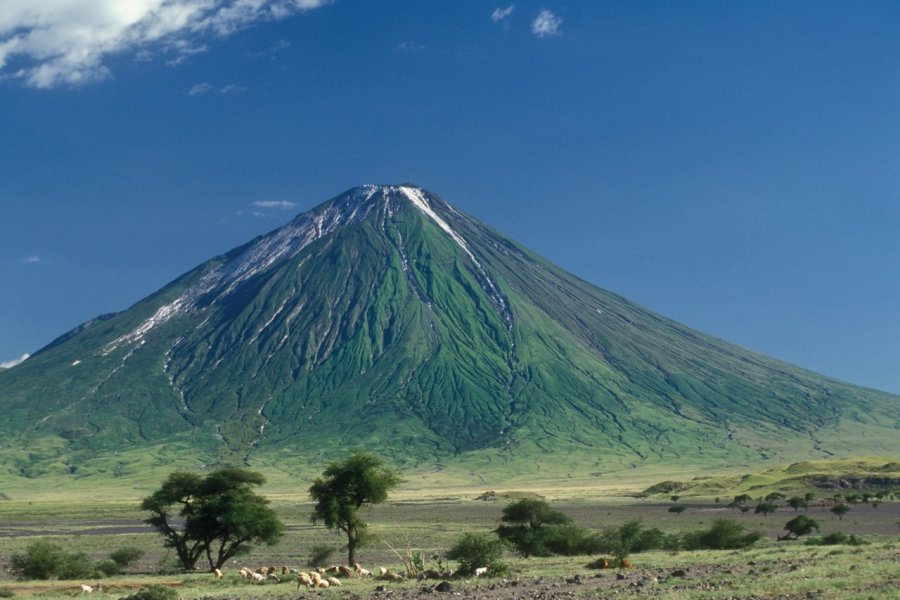Travel Guide Ol Doinyo Lengai
Find an accommodation
Advertising
The village of Engaresero (or Ngare Seru), on the road between Engaruka and Lake Natron, is the base for the ascent of the conical mountain that can be spotted from afar, Mount Ol Doinyo Lengai, the sacred mountain of the Maasai, but also the base for the excursions offered around Lake Natron by the Maasai community. A lively village teeming with piki-piki, small tin shops, children playing under the acacias, Maasai yoyas trying to sell a few jewels, a school that you can visit with your guide during the day and a handful of bars where you can go out in the evening and discover the local nightlife.The mountain of Ol Doinyo Lengaï towers 2,878 m above Lake Natron and stands out in the savannah landscape, often escorted by white clouds appearing as thick wisps of smoke (but they are clouds today). It's a roughly circular mountain, conical on the horizon like any volcano, but in reality with concave (and therefore increasingly steep) slopes. On the crest, from which there is a superb view of this 500 m-diameter crater, greenish or yellowish fissures appear, releasing sulphur-laden fumes. Lengaï's lava is particularly composed of sodium carbonate (Na2CO3), which solidifies within 48 hours of being exposed to the air, taking on a white color, even brighter in the sunlight. From a distance, on the road from the Serengeti to Olduvai, for example, this gives the impression that the volcano is covered in snow.Religion. the "Mountain of God", in the Maasai language, is of paramount importance to this Nilotic tribe. Although they were converted to Christianity by missionaries who provided them with a small amount of material assistance, the Maasai are profoundly animist and believe in the spirits of nature, regardless of whether their totally pagan traditions fit in with Christian precepts, and so much the better. The sky is considered God, and blue is sacred, symbolizing the Almighty as well as fertility (and is traditionally worn by women). The Maasai, however far away they may be from the sacred mountain, regularly make pilgrimages there, sacrificing animals to invoke the gods and ask for clement rains, fertile soil for their animals, numerous offspring or peace between villages. The grievances were numerous. But the fervour was most impressive during the last major eruption in 2008. Virgin women were asked to collect the hot ashes of the volcano threatening the villages, as offerings from God, singing and praying to the volcano day and night. No one wanted to be evacuated, despite the government's insistence on protecting local populations from a possible eruption.Volcanology. Haroun Tazieff came to observe Ol Doinyo Lengaï, the only active volcano on the Great Rift before those in Ethiopia, one of the youngest volcanoes in East Africa and perhaps the most active. The volcanologist came especially to study this highly fluid lava - with a viscosity comparable to water, imagine that! - It's much cooler than other types of lava, melting at "only" 500°C. The last major eruptions took place in 1992, 1983 and, above all, 1967, followed by 2007 and 2008. The 1967 eruption was the most violent, scattering hot ash as far as Seronera, 100 km away. Thousands of livestock were poisoned by the volcano's toxic ash. In 2007 and 2008, lava flowed spectacularly from the crater in 4 eruptions. Since then, the volcano has been relatively calm, but could erupt at any time.
Suggested addresses Ol Doinyo Lengai
Weather at the moment
Advertising
Organize your trip with our partners Ol Doinyo Lengai
Transportation
Book your plane tickets
Car Rental
Boat rental
Accommodation & stays
Find a hotel
Holiday rental
Find your campsite
Tailor-made trip
Immersion travel
Services / On site
Activities & visits
Find a doctor




